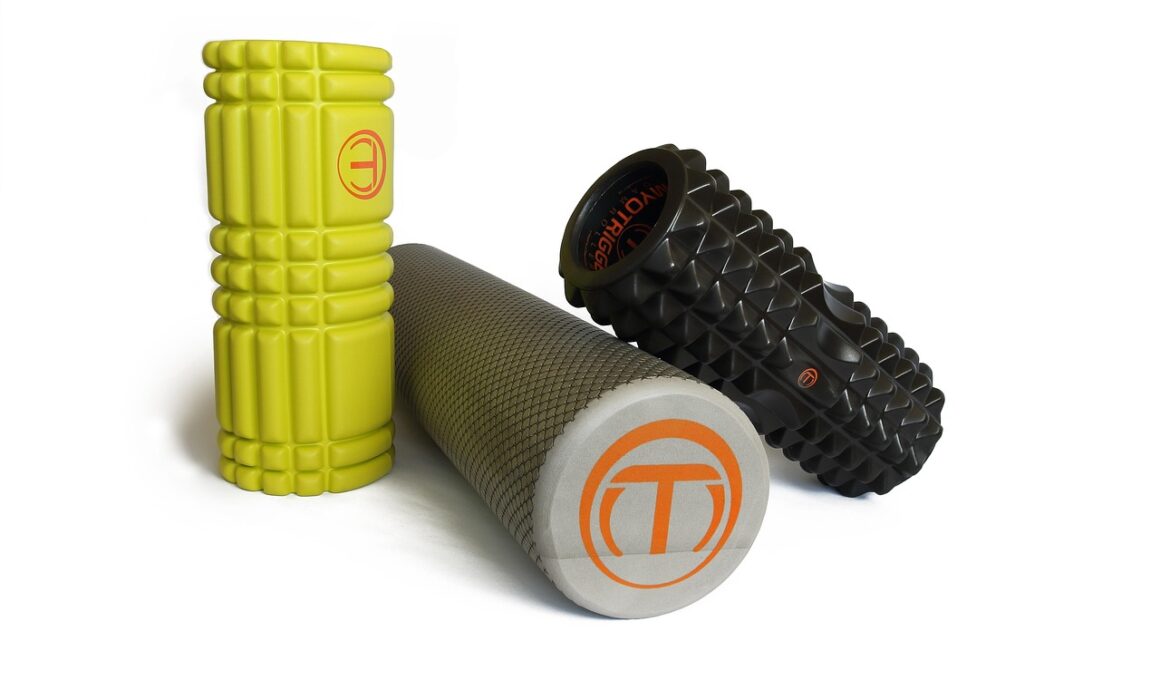Advanced Self-Myofascial Release Techniques for Experienced Athletes
Self-myofascial release (SMR) is a widely recognized technique that helps athletes manage muscle pain and enhance recovery through self-applied pressure on muscles. By using tools such as foam rollers or massage balls, athletes can target areas of tightness and discomfort. SMR works by releasing trigger points, which are hyper-contracted muscle fibers that can cause pain, limit movement, and impair athletic performance. This advanced method goes beyond basic SMR, offering more intricate techniques suitable for experienced athletes. Incorporating advanced techniques can significantly improve flexibility, reduce soreness, and promote faster recovery. The deeper understanding of the fascial system in combination with SMR can enhance athletic performance and overall well-being. Athletes of all levels should dedicate time to exploring these techniques as they provide invaluable benefits. Advanced SMR often includes variations like positional release, team-based applications, and combines stretching elements for enhanced effects. Practicing these skills not only promotes better function but encourages athletes to develop a deeper connection with their bodies. When done regularly, SMR can become an integral part of an athlete’s training regimen to maintain optimal performance throughout their athletic endeavors.
One of the key components of advanced self-myofascial release techniques involves understanding the anatomy of muscles and fascia. Knowledge of the muscular system allows athletes to identify areas that require more attention during self-release practices. Key muscles involved in sports often endure excessive tension, leading to potential injuries. By targeting these areas effectively, athletes can prevent injury and enhance their performance. Techniques such as sustained pressure, dynamic movements while rolling, and controlled breathing are essential in optimizing the SMR process. Sustained pressure encourages blood flow, while dynamic movements help loosen tissues adjacent to muscles. Another invaluable aspect of advanced SMR is integrating it with stretching routines post-massage. This combination allows for enhanced soft-tissue relaxation and improved flexibility. Athletes should experiment with various pressures and durations depending on their comfort and specific needs. As athletes work on their technique, consistency is vital; practicing SMR at least a few times a week can yield tremendous benefits. This not only supports recovery but aids in overall muscle health that tends to deteriorate without proper care. Advanced SMR enhances the relationship between mind and body, allowing athletes to engage more effectively with their physicality.
Techniques for Targeting Specific Muscle Groups
Targeting specific muscle groups is a vital aspect of advanced self-myofascial release. Certain activities challenge distinct muscles, requiring a tailored approach. For instance, runners may experience tightness in their calves, quadriceps, and hip flexors. Utilizing SMR techniques such as rolling or applying pressure to these areas can alleviate discomfort and enhance overall performance. Using a foam roller for the quadriceps involves positioning the roller under the thigh and using body weight to apply pressure, while shortening the muscle by bending the knee during the process increases effectiveness. For hip flexors, athletes can position themselves into a lunge while rolling over the front of the hip. Also, massage balls can be incredibly effective when targeting small and intricate bands of muscle fiber that are tough to reach. By leveraging these advanced techniques, experienced athletes can directly address issues before they escalate into injuries, fostering a proactive approach to muscle care. Understanding where and how to strategically apply these techniques enhances the overall rehabilitation and injury prevention strategies. Ultimately, integrating a variety of techniques enables a more holistic recovery process, promoting athletic longevity and peak performance in any sport.
In addition to individual muscle targeting, pre-workout self-myofascial release can enhance athletic performance by preparing the body for intense activity. Engaging in SMR just before training helps increase blood flow to the muscles and releases tension that could hinder movement. The rationale is to promote suppleness and flexibility, reducing the risk of strains or tears. Athletes are encouraged to focus not only on major muscle groups but also to incorporate SMR into their dynamic warm-up routines. Techniques such as using a foam roller on the back, glutes, and legs create an optimal state for muscle function. Furthermore, athletes should incorporate breathing techniques, maintaining steady and controlled inhalation and exhalation to facilitate relaxation during the process. Incorporating these practices increases awareness of muscle and fascia health, significantly aiding performance outcomes. Athletes should experiment with timing their SMR sessions around their athletic activities. Discovering the right duration, intensity, and specific techniques integrated into their routines can lead to remarkable decreases in injuries. As the understanding of these principles grows, athletes identify unique strategies that appeal to their needs, ultimately enjoying enhanced capabilities in their respective sports.
Post-Workout Recovery Techniques
Effective post-workout recovery techniques are essential for athletes who wish to maintain their training regimen without interruptions from injuries or excessive soreness. Advanced self-myofascial release plays a pivotal role in this recovery phase, helping to unwind tight muscles and restore flexibility after intense training sessions. Focus should remain on large muscle groups that exhibit tension post-exercise. Achieving this involves spending more time rolling over areas of discomfort and allowing the muscles to relax into the roller or ball used. Techniques such as rolling for longer durations or combining SMR with static stretches yields remarkable results. For example, completing a series of sustained rolls over the hamstrings followed by stretches can lead to superior recovery outcomes. The window of opportunity post-exercise is critical, and effectively addressing muscle tightness can expedite recovery times. Athletes who develop a routine that incorporates these advanced SMR techniques are more likely to experience reduced soreness and increased mobility in subsequent workouts. Designing a personalized SMR routine in conjunction with overall recovery strategies can drastically enhance performance during future physical activities, ensuring athletes remain at their peak capability.
It is essential to develop a structured self-myofascial release routine that aligns with an athlete’s training schedule. Consistency is key, as regular practice can lead to enhanced recovery, reduced injuries, and optimal performance. Experienced athletes should assess and revise their SMR routines based on their ongoing physical demands. By observing how specific muscles respond to different techniques, athletes can tailor their practices to provide maximum effectiveness. Experimentation and flexibility in approaching SMR can yield valuable insights into personal needs and preferences. Another essential point for establishing a routine involves education. Athletes should familiarize themselves with various SMR tools and techniques, understanding which methods correlate with their sports and the types of muscles used. Consideration should also be given to the use of technology such as instructional videos or mobile applications designed for self-myofascial release. These resources can enhance learning and adoption of new techniques, improving overall engagement in the practice. Building an advanced SMR routine not only supports individual performance but fosters a culture of self-care, aiding athletes in their endeavors towards injury prevention and overall wellbeing.
Conclusion on the Importance of Advanced SMR
The significance of advanced self-myofascial release techniques cannot be overstated for athletes aiming to optimize their performance and maintain their physical health. With a comprehensive understanding of muscle anatomy and the appropriate methods, athletes gain the ability to self-manage their muscle health proactively. The combination of preventive action through SMR, targeted techniques for specific areas, and post-workout recovery practices creates an integral part of an athlete’s training. As they continue to explore innovative techniques, embracing these advanced methods can enhance not only athletic performance but overall quality of life. Emphasizing the incorporation of regular self-myofascial release integrates seamlessly into training programs, creating a culture of health-conscious behaviors. Additionally, long-term benefits include injury prevention and improved mobility. Experienced athletes should be encouraged to continuously learn about new methodologies and approaches in SMR. Ultimately, dedication to developing a structured practice and making time for self-care can lead to remarkable advancements in athletic performance. Thus, incorporating advanced self-myofascial release techniques is not just beneficial; it is critical for achieving lasting success within competitive environments.
For anyone delving into the world of self-myofascial release, commitment and regular practice are essential for observing its full potential effects. By taking ownership of one’s muscle health through effective techniques, athletes will find they possess greater overall wellness. Investing effort into understanding the various modalities available will invariably pay dividends in both physical and mental resilience. As the sports industry evolves, the importance of injury prevention and rehabilitation will continue to remain paramount. Athletes must adapt to change, nurturing their bodies in accordance with specific training demands. Overall, a proactive approach to self-myofascial release encourages a deeper awareness of the mind-body connection while fostering stronger relationships between athletes and their own performance. As awareness grows around these advanced SMR techniques, athletes stand to gain a significant edge in their sport, armed with the tools necessary to enhance recovery. With consistency and dedication, they will maximize their physical capabilities while safeguarding themselves against injury. Thus, advanced self-myofascial release represents not merely a technique but a transformative practice capable of uplifting athletic endeavors and helping each athlete reach their fullest potential.


